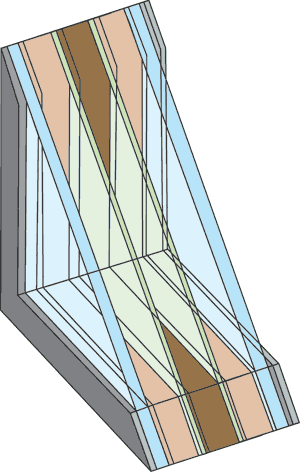A respected builder I know told me how he learned the true value of energy-efficient windows. In the course of his business, he installed a builder's line of windows from a well-known manufacturer in every house he built. He felt good about his choice; he purchased the windows from a manufacturer with a reputation for quality but they cost 10% less than the same manufacturer's standard line of low-E, argon filled windows saving him about $600 per house he installed the new windows in. He even put them in his own house. The first winter he lived there, he noticed that the windows seemed cold. Only then did he compare the U-values with the same manufacturer's standard windows. he did some math and concluded that his windows were costing him about $150 a year. By his estimation, the low-E windows would have paid for themselves in four years and made his home more comfortable for their entire life span.
Experiences such as his are common, yes they are easily avoidable with a basic understanding of how energy-efficient windows work. When you choose new windows, appearance is often first considered. Initial cost is the next issue: "Which window within the favored style costs the lease"? Liking a window's appearance i a fuzzy proposition and cost really depends on the durability and on the energy dollars pumped through the windows each year. I am convinced that if we could see energy loss a we see color and shape, energy performance would top the list of window considerations.
Windows are thermal holes. An average home may lose 30% of its heat or air conditioning energy through its windows. Energy-efficient windows save money each and every month. There are even some cases where new windows can be net energy gainers. The payback period for selecting energy-efficient units ranges from two years to ten years. In new construction, their higher initial cost can be offset because you'll probably need a smaller, less expensive heating and cooling system. And more durable windows may cost less in the long haul because of lowered maintenance and replacement costs. Plus, you'll be more comfortable the whole you live in your home.
Windows lose and gain heat by conduction, convection, radiations and air leakage. This heat transfer is expressed with U-values or U-factors. U-values are the mathematical inverse of R-values. So an R-value of 2 equals a U-value of 1/2 or .5. Unlike R-values, lower U-value indicated higher insulating value.
Air leakage siphons about half of an average home's heating and cooling energy to the outdoors. Air leakage through windows is responsible for much of this lose. Well-designed windows have durable weatherstripping and high quality closing devices that effectively block air leakage. Hinged windows such as a casement and awnings clamp more tightly against weather stripping than do double-hung windows. But the difference is slight; well-made double hungs are acceptable. How well the individual pieces of the window unit are joined together also affects air leakage. Glass-to-frame, frame-to-frame and sash-to-frame connections must be tight. The technical specifications for windows list values for air leakage as cubic feet per minute per square foot of window. It is important to find Denver windows with certified air-leakage rates of less than .3 cfm/ft2. The lower the value the better.
This content was from the book "The Best of Fine Homebuilding: Energy-Efficient Building"

Thanks for sharing such a great blog... I am impressed with you taking time to post a nice info.
ReplyDeleteCheap Window Installation
Windows And Doors Phoenix
Home Window Installation
Vinyl Double Hung Windows
Sliding Window Replacement